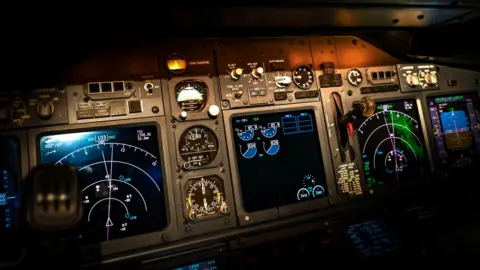Empty line 4
Investigators have unearthed unsettling details about the Air India Flight 171 crash that claimed the lives of 260 people in June. The preliminary analysis reveals a shocking occurrence just seconds after takeoff: both fuel-control switches on the Boeing 787 Dreamliner switched abruptly to the "cut-off" position, shutting off fuel supply and leaving the engines powerless. This action is generally reserved for landing, raising alarms about the circumstances under which it occurred.
The cockpit voice recorder reveals a haunting exchange between the pilots, with one asking why the other toggled the cut-off switch, to which the responding pilot claimed he did not. The identities of the voices remain unclear, along with the context surrounding this critical moment. At takeoff, the co-pilot was at the controls while the captain was monitoring, and the switches were returned to their normal positions, leading to an automatic relight of the engines. However, time was short, as the flight only lasted 40 seconds before crashing into a densely populated area in Ahmedabad.
The ongoing investigation, spearheaded by Indian authorities in collaboration with aviation experts from organizations like Boeing and the U.S. National Transportation Safety Board (NTSB), has encountered numerous challenges. A key concern is the inherent safety feature of the lever-lock fuel switches, designed to prevent accidental activation. Experts emphasize the difficulty of simultaneously switching off both valves, which casts doubt on the possibility of an inadvertent error.
Former airline accident investigator Shawn Pruchnicki expressed astonishment at the pilots' action and questioned whether it was intentional or a result of miscommunication, especially as the pilots reported no abnormal conditions. Former NTSB director Peter Goelz remarked on the chilling nature of one pilot's query regarding the switch, suggesting that the conversation holds deeper implications.
The cockpit voice recorder and its contents are of utmost importance. Analysts are looking for a clear transcription to identify each pilot's voice and reconstruct the events that unfolded during the flight. Proposals for mandatory cockpit video recording systems have surfaced as critical additions for future safety enhancements.
Additionally, the report alludes to ongoing inquiries about the Boeing 787's fuel control switches following a bulletin by the U.S. Federal Aviation Administration (FAA) warning about a potential disengagement of the locking feature on similar aircraft. Whether this malfunction contributed to the crash remains an acutely relevant issue amid speculation about possible electronic triggers initiating the cut-off.
Fuel contamination has also been dismissed as a cause, and recent evidence indicates a larger systems failure—evident in the deployment of the Ram Air Turbine (RAT)—which automatically activates when both engines experience power loss.
Pilot reactions during emergencies highlight the high stakes of flight management when faced with unexpected situations. The crew's attempts to stabilize the plane were impeded by time constraints and mechanical failures, culminating in a tragedy that demands further investigation and a thorough understanding of the circumstances leading to the crash.
Investigators have unearthed unsettling details about the Air India Flight 171 crash that claimed the lives of 260 people in June. The preliminary analysis reveals a shocking occurrence just seconds after takeoff: both fuel-control switches on the Boeing 787 Dreamliner switched abruptly to the "cut-off" position, shutting off fuel supply and leaving the engines powerless. This action is generally reserved for landing, raising alarms about the circumstances under which it occurred.
The cockpit voice recorder reveals a haunting exchange between the pilots, with one asking why the other toggled the cut-off switch, to which the responding pilot claimed he did not. The identities of the voices remain unclear, along with the context surrounding this critical moment. At takeoff, the co-pilot was at the controls while the captain was monitoring, and the switches were returned to their normal positions, leading to an automatic relight of the engines. However, time was short, as the flight only lasted 40 seconds before crashing into a densely populated area in Ahmedabad.
The ongoing investigation, spearheaded by Indian authorities in collaboration with aviation experts from organizations like Boeing and the U.S. National Transportation Safety Board (NTSB), has encountered numerous challenges. A key concern is the inherent safety feature of the lever-lock fuel switches, designed to prevent accidental activation. Experts emphasize the difficulty of simultaneously switching off both valves, which casts doubt on the possibility of an inadvertent error.
Former airline accident investigator Shawn Pruchnicki expressed astonishment at the pilots' action and questioned whether it was intentional or a result of miscommunication, especially as the pilots reported no abnormal conditions. Former NTSB director Peter Goelz remarked on the chilling nature of one pilot's query regarding the switch, suggesting that the conversation holds deeper implications.
The cockpit voice recorder and its contents are of utmost importance. Analysts are looking for a clear transcription to identify each pilot's voice and reconstruct the events that unfolded during the flight. Proposals for mandatory cockpit video recording systems have surfaced as critical additions for future safety enhancements.
Additionally, the report alludes to ongoing inquiries about the Boeing 787's fuel control switches following a bulletin by the U.S. Federal Aviation Administration (FAA) warning about a potential disengagement of the locking feature on similar aircraft. Whether this malfunction contributed to the crash remains an acutely relevant issue amid speculation about possible electronic triggers initiating the cut-off.
Fuel contamination has also been dismissed as a cause, and recent evidence indicates a larger systems failure—evident in the deployment of the Ram Air Turbine (RAT)—which automatically activates when both engines experience power loss.
Pilot reactions during emergencies highlight the high stakes of flight management when faced with unexpected situations. The crew's attempts to stabilize the plane were impeded by time constraints and mechanical failures, culminating in a tragedy that demands further investigation and a thorough understanding of the circumstances leading to the crash.





















